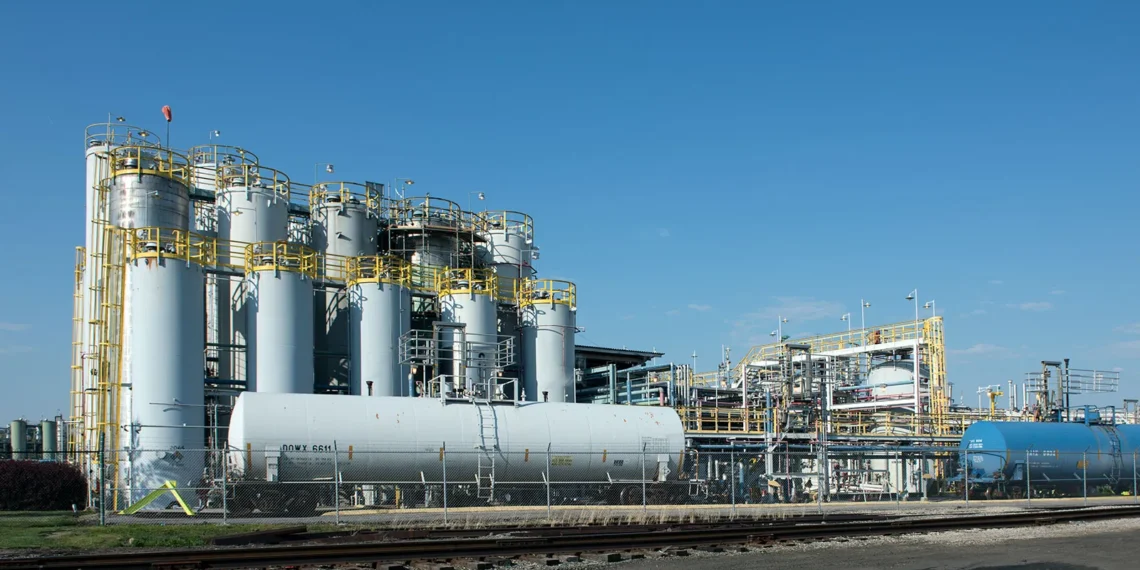Dow Chemical Pioneer of the Chemical Industry and Modern Challenges
Dow Chemical (now operating under Dow Inc.) has evolved from a small bromine-extraction venture into one of the world’s largest materials science companies. This article explores Dow Chemical’s founding, its rise to global leadership, recent industry challenges, and its strategic pivots in 2025. You’ll gain an in-depth understanding of how Dow Chemical continues to shape the chemical industry today.
The Founding and Rise of Dow Chemical
Humble Beginnings and Early Innovation
Dow Chemical was founded in 1897 by Herbert H. Dow in Midland, Michigan, after he developed an electrochemical method to extract bromine from brine. This method launched the company’s first profitable venture and set its innovative tone from the start. Despite early failures—Dow had been ousted twice in earlier ventures—his perseverance built a lasting legacy Dow CorporateDow Corporate.
By the early 1900s, Dow had expanded into bleach, agricultural chemicals, and other inorganic compounds, with early trademarks and rapidly growing product lines such as phenol, magnesium, acetylsalicylic acid and chlorine-based products by World War I Dow CorporateDow Corporate.
Golden Era of Diversification
Between the 1920s and 1940s, Dow committed heavily to research. Innovations like STYROFOAM™, PVC, Saran Wrap®, and ion exchange resins marked Dow’s leadership in materials science. The company hired its first female researcher, Sylvia Stoesser, who helped pioneer safer solvents and polymer development, laying the groundwork for mass-market plastics and synthetic rubber Dow CorporateWikipedia.
Corporate Evolution and Merger Spinoffs
Mergers, Spinoffs and Modern Structure
Over decades, Dow expanded globally and diversified further. In 2017, Dow Chemical merged with DuPont to form DowDuPont in a massive $130 billion deal. By 2019, the company spun off into three independent entities: Dow Inc., Corteva Agriscience, and the rebranded DuPont. Dow Inc. became the materials science-focused successor of Dow Chemical WikipediaWikipediainvestopedia.com.
It fully assumed ownership of Dow Corning’s silicones business in 2016, consolidating its core competencies in materials science and innovation Dow CorporateWikipedia.
Dow Chemical Today—Structures, Finances & Governance
Global Reach and Business Scale
Today, Dow Inc. (formerly Dow Chemical) operates in roughly 160 countries with about 36,000 employees globally. In 2024, it generated around $43 billion in revenue, ranking it among the top chemical producers worldwide Encyclopedia BritannicaDow Investor RelationsWikipedia. Jim Fitterling, CEO and Chairman, leads the company with deep industry insight and operational experience Wikipedia.
Recent Financial Performance
In Q2 2025, Dow Chemical reported net sales of $10.1 billion—a 7% decline year-over-year—and posted a GAAP net loss of $801 million. Operating EBIT fell sharply to a $21 million loss, driven by depressed pricing and softened margins across most segments. Cash flow from operations was negative $470 million, although dividends paid exceeded $496 million Dow Investor Relations.
Strategic Shifts and Portfolio Rebalancing
Asset Sales and Joint Venture Exits
In June 2025, Dow Chemical signed an agreement to sell its 50% stake in DowAksa, a composites joint venture, for roughly $125 million. The move aligns with Dow’s strategy to focus on high-value downstream businesses and capitalize on its core segments Dow Investor Relations.
European Rationalization and Cost Cuts
Facing protracted demand downturns in chemical markets, Dow Chemical announced plans in 2025 to idle or shutdown upstream assets in Europe—including facilities in Böhlen (Germany), Schkopau (Germany), and Barry (U.K.). These actions are expected to deliver material margin improvements by 2026 and beyond, as part of a cost reduction and profitability strategy Dow Investor RelationsChemical & Engineering News.
Dow also delayed its ambitious Path2Zero ethylene project in Alberta and is cutting capital expenditure estimates for 2025 to $2.5 billion from an earlier projection of $3.5 billion Chemical & Engineering NewsPR Newswire.
Legal Battles and Regulatory Challenges
Major Legal Victory in Alberta
In June 2025, a Canadian court ruled that NOVA Chemicals must pay Dow Chemical approximately CAD 1.62 billion (USD 1.2 billion) in additional damages. This award is related to contract breaches in a shared ethylene asset in Joffre, Alberta, and follows a prior payment of CAD 1.43 billion in 2019. The final settlement is expected by late 2025, pending possible appeal Dow CorporateDow Investor Relations.
Environmental Litigation in New Jersey
In April 2025, Dow Inc. appealed a New Jersey environmental lawsuit seeking to move the case from state to federal court. The suit alleges Dow knowingly contaminated local waterways with 1,4-dioxane—a probable human carcinogen. Dow argues that the case should be tried federally due to its sales of the product under government contracts dating to the Vietnam War era. Judges remain skeptical of this defense under current interpretations of the federal officer removal statute Midland Daily NewsWikipedia.
Public Controversies & Safety Oversight
Legacy of Protest and Environmental Scrutiny
Dow’s history includes protests dating back to 1967 over its association with the U.S. military’s production of napalm during the Vietnam War, triggering student sit-ins and national attention. These protests became a turning point in campus activism and Dow’s public image as a controversial chemical firm Wikipedia.
The company also continues facing public attention over industrial accidents, including a significant ethylene oxide release in Plaquemine, Louisiana, in July 2023. A federal agency investigation into that incident is now at risk as the Trump administration proposes shutting down the Chemical Safety and Hazard Investigation Board (CSB) altogether—a move criticized by environmental and safety advocates Midland Daily News.
Regulatory Exemptions and Public Health Concerns
In July 2025, Dow and 24 other U.S. chemical sites received a two-year exemption from EPA’s updated pollution rules, citing national security and resilience concerns. The exemption allows continued emissions of regulated pollutants, drawing criticism from environmentalists worried about public and environmental health Midland Daily News.
Innovation, Sustainability, and Market Differentiation
R&D Culture and Sustainable Ambitions
Since its founding by Herbert H. Dow, Dow Chemical has focused on innovation—from early bromine extraction to modern plastic polymers and silicones. Today, the company emphasizes materials science with a growing sustainability remit: cleaner production, circular economy packaging solutions, and carbon capture pathways in projects like Path2Zero Dow CorporateDow CorporatePR Newswire.
Strategic Innovation in Packaging and Coatings
In June 2025, Dow introduced its INNATE™ TF 220 precision packaging resin, aimed at promoting packaging circularity through advanced material design. This product reflects the company’s efforts to redefine plastics use in a more sustainable, customer-centric model Dow Corporate.
The Broader Chemical Industry Landscape
Trade, Tariffs, and Global Supply Chains
Dow faces additional external pressure in 2025 as the U.S. considered imposing steep tariffs on Brazilian chemical exports. Since Dow Chemical operates multiple plants in Brazil and exports silicon-related products, these trade tensions could disrupt supply chains and lead to order cancellations, especially in resin and fertilizer markets reuters.com.
Dow Chemical – Legacy, Challenges & a Transforming Future
Dow Chemical has withstood more than a century of industrial, legal, and market upheavals. While its roots lie in bromine extraction and early plastics, today the company navigates global legal disputes, regulatory uncertainty, and economic slowdown—even as it redefines operations with sustainability and profitability goals.
Conclusion: The Path Ahead for Dow Chemical
Despite financial headwinds and reputational scrutiny, Dow Chemical remains resilient—anchored by innovation, legal victories, and a lean toward sustainable materials science. In 2025, the company is actively reshaping its portfolio: pruning upstream assets, exiting non-core ventures, pursuing efficiency through cost-cutting, and reinforcing its innovation credentials.
The company’s legacy—from H.H. Dow’s “crazy” ambition to global household products—is steeped in scientific advancement. Now, as it closes plants and reforms its structure, Dow Chemical’s next chapter hinges on balancing environmental responsibility with operational agility. Its ability to navigate lawsuits, public trust, and shifting trade policies will define its standing in the decades ahead.
Whether you’re a student of business history, environmental law, or industrial innovation, the evolution of Dow Chemical stands as a compelling study in adaptation and reinvention.









